![]()
![]()
![]()
Use LEFT and RIGHT arrow keys to navigate between flashcards;
Use UP and DOWN arrow keys to flip the card;
H to show hint;
A reads text to speech;
126 Cards in this Set
- Front
- Back
|
How does the size of an organism relate with its surface area to volume ratio?
|
Larger the organism, the smaller its SA:V ratio
|
|
|
What are the features of a specialised exchange surface?
|
Large SA:V ratio- increased rate of exchange Very thin- diffusion distance is short therefore materials can pass across rapidly selectively permeable allows selected materials across moving medium and transport systems to ensure movement of mediums maintains Conc Gradient |
|
|
What is the equation to find diffusion
|

|
|
|
How is gas exchanged in a single cell organism
|
simple diffusion
|
|
|
Draw and label the internal tracheal system
|

|
|
|
What are the advantages of the features of the exchange surface for insects? (1) Tracheoles |
large numbers of Highly branched (1) for large SA Thin walls of (1) short diffusion distance Tubes full of air- faster diffusion rate muscles contract causing body movement- maintains conc gradient |
|
|
How does diffusion (in an Insect) use a concentration gradient?
|
Lower conc of Oxygen in the muscle/tissue as it is being used up in respiration so oxygen diffuses into spiracles along conc grad to muscles. Higher conc of CO2 in muscles as a waste product of respiration and so CO2 moves out of spiracle along the conc gradient and out of the insect.
|
|
|
How does diffusion (in insects) use Mass transport?
|
Contraction of muscles can squeeze trachea enabling mass movement of air in and out. Speeds up exchange
|
|
|
How does diffusion (in insects) use the fact that the ends of the trachea are filled with water?
|
major activity- increased anaerobic respiration produces lactate (soluble) which lowers water potential of tissue/muscle. water moves in by osmosis. water at ends of tracheols decrease in volume so draws air further into them. so final diffusion pathway is in a gas making it more rapid. leads to greater water evaporation. |
|
|
what controls the opening and closing of spiricles and what does the opening and closing of the spircles mean?
|
valves. opening means that there will be water loss by evaporation
|
|
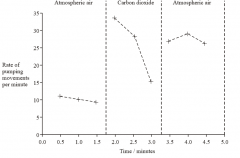
Explain the rise in the rate of abdominal pumping from 1.5 to 2.0 mins.
|
lack of oxygen and higher co2 concentration
|
|
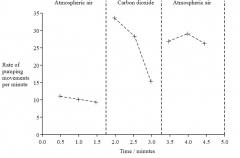
explain the fall in the rate of abdominal pumping movements between 2.0 and 3.0 mins
|
lack of oxygen. less respiration. less energy. decrease in muscle contractions. lower pumping rate
|
|
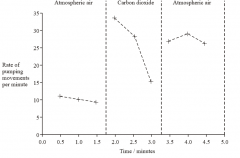
what is the advantage of the abdominal rate increasing between 3.0 and 3.5 mins?
|
pay back oxygen debt and get rid of lactic acid
|
|
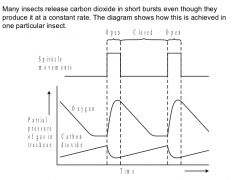
what, suggested by the graph, stimulates the spiracles to open?
|
increase in CO2
|
|
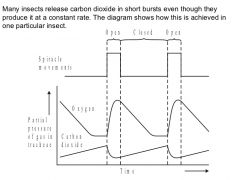
what causes oxygen levels to fall when spiracles are closed?
|
oxygen is used up in respiration as it diffuses from trachea to muscle cells to release energy
|
|
|
in dry conditions, why is the pattern of the spiracle movements advantageous?
|
Spiracles are not open all the time so it prevents too much water loss
|
|
|
label the exchange surface of a fish
|
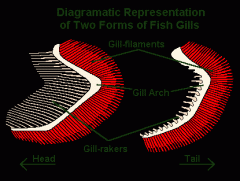
|
|
|
define concurrent
|
systems reach equilibrium and no further exchange can take place
|
|
|
what is counter current?
|
systems do not reach equilibrium and exchange takes place along the whole length. Blood flows in opposite direction to the water.
|
|
|
Describe the features of the gill that gives them a large surface area?
|
multiple gill arches with multiple filaments with many lamella
|
|
|
Describe the relationship between gills, surface area, mass and swimming speed.
|
An increase in Mass and swimming speed are proportionate to an increase in the gill
|
|
|
How does inspiration take place in a fish?
|
Mouth opens and muscles in mouth contract causing floor of mouth to move lower. The opercula muscles contract causing the opercula to move outwards. These movements increase volume in the buccal and opercula cavity which lowers pressure. water pressure pushes the opercula valve close and water flows through open mouth and over the gills down a conc gradient.
|
|
|
How are leaves adapted for good exchange?
|
Thin &Flat so large SA:V ratio and short diffusion pathway for high absorption of light. Air spaces and stomata for fast diffusion through air Guard cells allows opening an closing of stomata which controls water loss and gas exchange |
|
|
What prevents water being lost from a upper epidermis?
|
Waxy cuticle acts as a water proof to prevent the evaporation of water
|
|
|
What is the structure of a leaf?
|
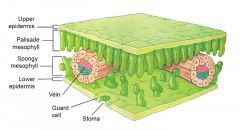
includes waxy cuticle and air spaces
|
|
|
what is a Xerophyte?
|
Plants that are adapted to living in areas where water is in short supply
|
|
|
What adaptions are there that are advantageous for xerophytes?
|
Thick waxy cuticle to reduce water loss by evaporation Hairy leaves which trap moist still air which reduces conc grad so less water lost by evaporation rolling up of leaves traps water in regions so reduces conc gradient reduced SA:V reduces rate of diffusion ratio |
|
|
What are examples of Xerophytes?
|
Holly and cactus
|
|
|
describe and explain how CO2 and O2 are exchanged between the chloroplasts and the outside air of a leaf.
|
Photosynthesis means that oxygen is produced in palisade mesophyll and leaves out of the stomata down the concentration gradient. Chloroplast uses Co2 in photosynthesis so enters the stomata down conc gradient.
|
|
|
What are three ways to reduce water loss in leaves?
|
Reduce surface area close pores/ point pores inwards to trap water so there is no conc gradient cell with hardened walls pointed outwards trapping water inside and preventing water loss. Thick walls means longer diffusion distance |
|
|
How is water loss limited in insects?
|
Small surface area to volume ratio Waterproof coverings over body surface (Chitin) Spiricles closed to reduce water loss |
|
|
How is water loss limited in plants?
|
Waterproof covering over leaves (Thick Cuticle) rolling up of leaves, stomata in grooves and hairy leaves traps region of still (Moist) air which reduces conc grad. reducing SA:V ratio e.g. small circular rather than long and flat |
|
|
Label the structure of the respiratory system
|
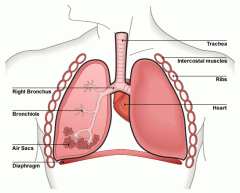
|
|
|
What is the position of the lungs?
|
Above diaphragm, between ribs on wither sides of the thorax
|
|
|
Describe the structure and function of the Trachea?
|
Flexible airways supported by rings of cartilage to prevent from collapse due to low pressure. Goblet cells (That line the trachea) trap dirt & Bacteria by the muscle it produces. Cilia cells move mucus up to the throat where it is swallowed |
|
|
Describe the structure and function of the Bronchi
|
2 divisions of trachea supported by less cartilage. captures dirt and bacteria and moves mucus towards the throat. Transfers air from lungs.
|
|
|
Describe the structure and function of the Bronchioles
|
Branches of Bronchi, walls are lined with epithelial cells. have no cartilage so rely on elastic muscles which allow them to control air in and out
|
|
|
Describe the structure and function of the Alveoli
|
Minute air sacs at the end of bronchioles which has elastic tissue allowing it to stretch when breathing in. Membrane is the gas exchange surface
|
|
|
Describe the structure and function of the Capillaries
|
allow for a good blood supply so concentration gradient is always maintained which increases diffusion rate
|
|
|
Why is a cartilage C shaped?
|
Allows for swallowing down the oesophagus. Allows for expansion of trachea during inhaling
|
|
|
How are the Squamous epithelial cells adapted for good exchange?
|
Flat and lining the surface and thin so short diffusion distance and large surface area to volume ratio
|
|
|
What increases the rate of diffusion in alvioli
|
walls are one cell thick so short diffusion distance many alvioli/ capillaries for increased SA:V squamous cells for short diffusion distance add increased surface are to volume ratio good circulation which maintains Conc Gradient |
|
|
why might red blood cells slow down as they pass through the pulmonary capillary?
|
allow more time for diffusion of oxygen |
|
|
Describe the process of inspiration
|
external intercostal muscles contriclt while internal relax which pulls ribs up and out. Daiphragm mucles contract -diaphragm flattens volume of thorax increases which reduced pressure atmospheric pressure is now greater so air is forced in-+ |
|
|
What is the pulmonary ventilation rate?
|
total volume of air moved into lungs during 1 minute.
|
|
|
What is Tidal Volume?
|
volume of air taken in at each breath when the body is at rest
|
|
|
What is ventilation rate?
|
the number of breaths taken in per minute
|
|
|
how is pulmonary ventilation rate (dm3min-1)measured?
|
Tidal volume (dm3) x Breathing rate (Min-1)
|
|
|
what is a correlation?
|
when a change in one variable is reflected by a change in another
|
|
|
What should be written if data shows a correlation and you are asked to evaluate it and the statement attached?
|
State the correlation. correlation does not prove causal relationship, more evidence needed as there may be other factors such as... |
|
|
What are risk factors for lung disease?
|
Smoking Air pollution Genetic makeup Infections Occupations |
|
|
label the parts of the digestive system
|
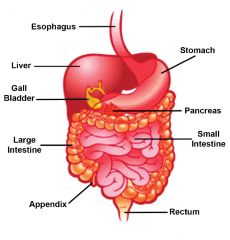
|
|
|
what is the function of the oesophagus?
|
carries food to from the mouth to the stomach
|
|
|
what is the function of the stomach?
|
muscular sac with an inner layer that produces enzymes. it stores and digests food, especially proteins. glands produce the enzymes
|
|
|
what is the function of the ileum?
|
long muscular tube. further digests food with enzymes that are produced by walls and glands. inner wall is folded into villi on epithelial cell for a large SA:V ratio
|
|
|
what is the function of the large intestine
|
absorbs water
|
|
|
what is the function of the rectum?
|
stores feaces before allowing them to be removed via the anus. it is called egestion
|
|
|
What is the function of the salivary glands?
|
situated near mouth and secrete amylase which hydrolyses starch into maltose
|
|
|
What is the function of the pancreas?
|
large gland situated below the stomach which produces pancreatic juices containing protease, lipase and amylase
|
|
|
where is Amylase produced, where does it act on and what does it do?
|
mouth and pancrease hydrolyses alternate glycosidc bondsa or starch molecules to produce maltose |
|
|
where is maltase produced, where does it act on and what does it do?
|
lining of ilium, hydrolyses maltose to a-glucose |
|
|
what are the steps to the breakdown of starch to maltose?
|
Salivary amylase is thoroughly mixed with food while chewing which hydrolyses the starch to maltose. Food is swallowed and enters stomach where the amylase is denatured by the acid. food is passed into small intestine and mixes with pancreatic amylase which further hydrolyses starch into moltose
|
|
|
what are the steps to the breakdown of maltose to a-glucose?
|
Muscles in ilium puch food along ilium and epethelial lining produces maltase (Membrane bound disaccharidase) which hydrolyses maltose into a-glucose
|
|
|
What are lipids hydrolysed by and what are the products of the hydrolysis?
|
lipase which break ester bond to form fatty acids and monoglycerides
|
|
|
where is lipase produced?
|
pancreas
|
|
|
what are the steps to the break down of lipids?
|
lipids are split into tiny droplets called micelles by bile salts (produced by the liver). the process is called emulsification and increases SA:V ration so that lipase action is faster
|
|
|
What are endopeptidases?
|
hydrolyse peptide bonds between amino acids in the central region of a protein molecule forming a series of peptide molecules. large polypeptide chain----> smaller polypeptide chain |
|
|
What are Exodipeptidases?
|
Hydrolyses peptide bonds on terminal amino acids and progressively release amino acids and dipeptides
|
|
|
What is Dipeptidases?
|
Hydrolyses peptide bond between the two amino acids in a dipeptide. dipeptides are membrane bound to the ilium. |
|
|
What is the structure of the ilium?
|
wall of ilium folded into villi and micro villi : increase SA for diffusion thin for short diffusion pathway contain muscles which enable movement which maintains conc grad as movement mixes content of ilium (Adjecent) well supplied with blood vessels for maintainance of conc gradient |
|
|
How does the absorption of amino acids and monosaccharides take place?
|
Diffusion and co-transport
|
|
|
how are triglycerides absorbed ? Monoglycerides and fatty acid (!) Triglycerides (@) Chylomicrons (%) |
micelles come into contact with epithelial cells of ilium causing them to break down, releasing the (!). Non polar so easily diffuse across the cell surface membrane, Once inside epithelial cell (!) are transported into the ER and into the Golgi. (@)+Cholesterol+lipoprotiens= (%)which move out by exocytosis and enter lymphatic vessel (Lacteal) and pass via the lymphatic node, into the blood system. (@) in (%) are hydrolysed by an enzyme in endothelial cells of blood capillary from which they diffuse into cells.
|
|
|
What is the structure of haemoglobin?
|
Globular quaternary structure protein 4 polypeptide chains (2 a-helix & 2 b-sheet) each chain contains a haem group associated with it (which can bind to oxygen) each haem group can combine with one O2 molecule |
|
|
What is association/ dissociation of oxygen?
|
Haemoglobin taking up oxygen/ haemoglobin releasing oxygen |
|
|
What does haemoglobin with a high affinity for oxygen do?
|
associates more easily but dissociated less easily
|
|
|
What is affinity does haemoglobin have for oxygen in the lungs?
|
High affinity as oxygen is high and oxy-haemoglobin is formed and so needs to associate readily.
|
|
|
What is affinity does haemoglobin have for oxygen in the respiring tissue?
|
low affinity as oxygen is needed for respiration so haemoglobin needs to dissociate readily.
|
|
|
What is the role of haemoglobin?
|
transport of oxygen. readily associate with oxygen at the surface where gas exchange takes place and readily dissociates from oxygen respiring tissue
|
|
|
Why are there different types of haemoglobin?
|
the shape of the molecule due to their amino acid sequence differs slightly in each organism so differ in tertiary structure and quaternary structure so have different oxygen binding properties.
|
|
|
What does the oxygen dissociation curve look like?
|
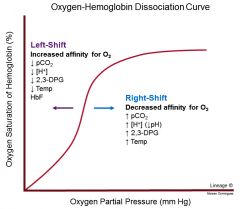
|
|
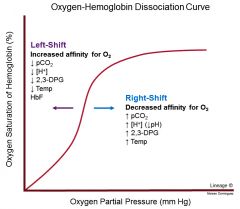
explain the initial shallowness of the curve
|
the shape of the haemoglobin makes it difficult for 1st oxygen molecule to bind because they are closely united. so at low concentrations, little oxygen binds to haemoglobin
|
|
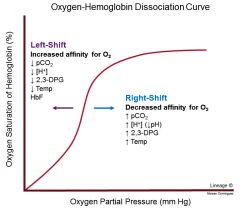
explain the initial steepness of the curve
|
binding of 1st oxygen molecule changes the quaternary structure of the haemoglobin so it is easier for 2 other oxygen molecules to bind to the other units on the polypeptide chains. a smaller increase in the partial pressure of oxygen is needed to bind the second oxygen compared to the first (positive cooperativity)
|
|
|
why does the dissociation curve start to flatten ?
|
it is harder to bind to fourth oxygen molecule sue to probability: majority of binding sites are occupied so it is less likely that the molecule will find an empty site
|
|
|
What is the Bohr effect?
|
states that there ishigh CO2 levels due to respiration in tissue so CO2 dissolves in tissue fluid. Carbonic acid is produced which lowers PH. Low PH reduces % saturation of haemoglobin breaks some bonds, changes shape makes dissociation easier |
|
|
What does a left shift in the dissociation curve describe?
|
left - greater affinity for oxygen so associates readily due to high PH, lower temperature and low external partial pressure.
|
|
|
What does a right shift in the dissociation curve describe?
|
right - Lower affinity for oxygen so dissociates readily. lower PH and higher temperature with a high external partial pressure.
|
|
|
what effect does CO2 have on the affinity of haemoglobin
|
low CO2 (in the lungs) means a higher affinity so readily associates High CO2 levels (in respiring tissue) means a lower affinity so dissociates readily |
|
|
What effect does temperature have on the affinity of haemoglobin?
|
Decreased temperature means a higher affinity for oxygen and respiration rate decreases and energy depletes to reduce loss in heat
|
|
|
How does the size of animal relate to the dissociation curve?
|
larger the animal the further left the dissociation curve
|
|
|
Explain the relationship between Surface area to volume ratio and the oxygen dissociation curve.
|
Large surface area to volume ratio rightward shift of dissociation cure as more heat lost so more respiration rate. Haemoglobin needs a lower affinity for oxygen as oxygen needs to dissociate rapidly |
|
|
how does the increase in the respiration of the mammalian tissue affect the oxygen dissociation curve?
|
shift the curve right due to high CO2 levels so haemoglobin dissociates from oxygen redily
|
|
|
people living in high altitudes have more red blood cells than those living at sea level. explain why
|
More haemoglobin means more association of oxygen
|
|
|
What is the advantage of people living in high altitudes having a rightward shift in the dissociation curve?
|
Lower affinity so oxygen dissociates readily and it is easier for O2 to reach respiring cells
|
|
|
why is Haemoglobin at a 97% saturation with oxygen when it leaves the lungs?
|
at high partial pressures there is low CO2 concentration which means that oxygen associates more readily
|
|
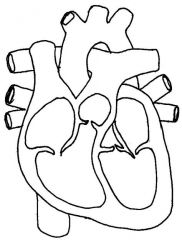
label the structure of the heart
|
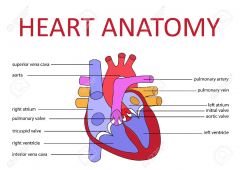
|
|
|
What are the key features of the heart?
|
closed systm of tubular vessels that branch to distribute medium around the body a form of mass transport in which the medium can be moved rapidly around large distances a suitable mechanism to transport substances A mechanism for moving the medium (contractins) |
|
|
Which side of the heart deals with oxygenated/ deoxygenated blood
|
left/right
|
|
|
Why is it important to prevent the mixing of blood?
|
mixing of oxygenated and deoxygenated blood would lower concentration gradient so less oxygen would reach respiring tissues and rate of diffusion is slower.
|
|
|
Why is the wall of the left ventricle thicker than that of the right ventricle?
|
blood in the left ventricle will travel further so will need stronger contractions of the muscles
|
|
|
Why does the internal volume of both ventricles need to be the same?
|
Equal volumes need to be pumped out as there needs to be an equal distribution of blood around the body
|
|
|
Why is the Pulmonary artery different to most arteries?
|
no other artery carry deoxygenated blood
|
|
|
Where are the coronary arteries found and what is the purpose?
|
on the external surface of the heart and supply cardiac muscle with glucose and oxygen for respiration and energy.
|
|
|
What is a myocardial infarction? what causes it and what effect does this have on the heart?
|
Heart attack. Blockage or coronary arteries. deprives heart muscles of blood and oxygen causing the cells to die and heart to weaken.
|
|
|
What happens during Diastole of the heart
|
all the muscles of the heart are relaxed
|
|
|
What happens during Atrial systole?
|
Blood enters atrium from vena cava/ pulmonary vein. Higher pressure in Atrium that ventricle causing the AV valves to open. Atrial muscles contract and blood flows into ventricle
|
|
|
What happens during Ventricular Systole?
|
Higher pressure in the ventricles than in the Atria or the pulmonary artery/ Aorta so the AV valves closa and semilunar valves open and ventricle muscles contract causing blood to flow in the Aorta/ Pulmonary artery
|
|
|
What happens when there is a higher blood pressure in the Aorta/ Pulmonary artery than in the ventricles?
|
Semi lunar valves close top prevent backflow of blood
|
|
|
What is the equation for cardiac output?
|
Cardiac output = Heart rate x Stroke volume dm3min-1 beatsmin-1 dm3 |
|
|
Define cardiac output
|
volume of blood pumped out of one ventricle of the heart in one minute
|
|
|
Define Heart rate
|
the rate at which the heart beats
|
|
|
Define stroke volume
|
volume of blood pumped out each beat
|
|
|
|
|
|
|
what is dm3 in cm3 and litres?
|
1dm3 = 1000cm3 = 1l
|
|
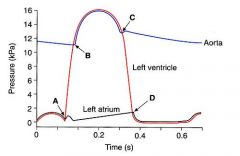
When are the semi lunar valves open and when are they closed?
|
B C |
|

At what point are the AV valves open and when are they closed?
|
D A |
|
|
What are arteries?
|
carry blood away from heart
|
|
|
What are arterioles?
|
smaller arteries that control blood flow from arteries to capillaries
|
|
|
what are Capillaries?
|
tiny vessels that linl arterioles to veins
|
|
|
what are veins?
|
carry blood from capillary, back to the heart
|
|
|
What are the structures of an artery structure related to its function in comparison to a vein?
|
Thicker muscle layer (can constrict and dilate in order to control volume of blood) Elastic layer is relatively thicker to stretch and recoil to maintain high pressure and smooth pressure surges. No valves |
|
|
What is the arteriole structure in comparison to arteries
|
muscle layer is relatively thicker to allow contraction and controls movement of blood elastic layer is relatively thinner as the blood pressure is lower |
|
|
What is the vein structure related to its function in comparison to the arteries?
|
muscle layer is relatively thinner as they cannot control blood flow elastic layer is relatively thin as there is a low pressure Overall thickness of wall is smaller as the pressure is too low Valves- prevents backflow due to low pressures and muscle contractions |
|
|
What is the capillary structure related to its function?
|
walls consist mostly of the lining layer (thin) so short diffusion pathway to increase diffusion rate Numerous and highly branched so large surface area for excahnge narrow diameter so diffusion distance between oxygen and walls is short spaces between endothelial cells allows white blood cells to leave to deal with infected tissue |
|
|
How is tissue fluid formed?
|
Blood pumped by heart passes along arteries. hydrostatic pressure is created at the arterial end of the capillary. this hydrostatic pressure causes tissue fluid to move out of the blood plasma but is opposed by hydrostatic pressure and the lower water potential which combines to create an overall pressure that pushes the fluid out of the capillaries. this pressure is only great enough to force small molecules out leaving all cells and proteins in the blood called ultrafiltration.
|
|
|
How is tissue fluid returned to the circulatory system?
|
loss of tissue fluid in cappilaries reduces the hydrostatic pressure within the by the time the blood has reached the venous end, the capillary networs hydrostatic pressure is lower than that of the tissue fluid out of it. therefore tissue fluid is forced back into capillaries by the higher hydrostatic pressure around them plasma has lost water and contains protiens ao a lower water potential is there so water leaves tissue by osmosis down water potential gradient |
|
|
What is the lymphatic system and what does it do to remaining tissue fluid?
|
system of vessels that begin in the tissuesmerge gradually into larger vessels that form a network throuout the body. the larger vessels drain the contents back into the blood stream via the two ducts that join the veins close to the heart. the contents are moved by hydrostatic pressure and the contraction of the heart muscles
|

